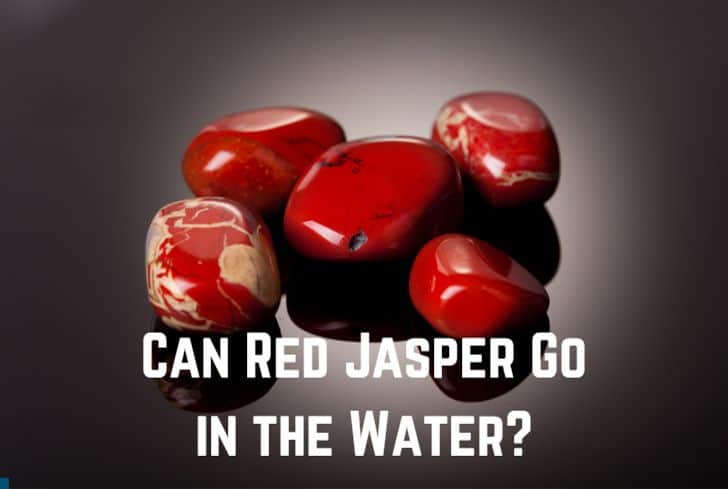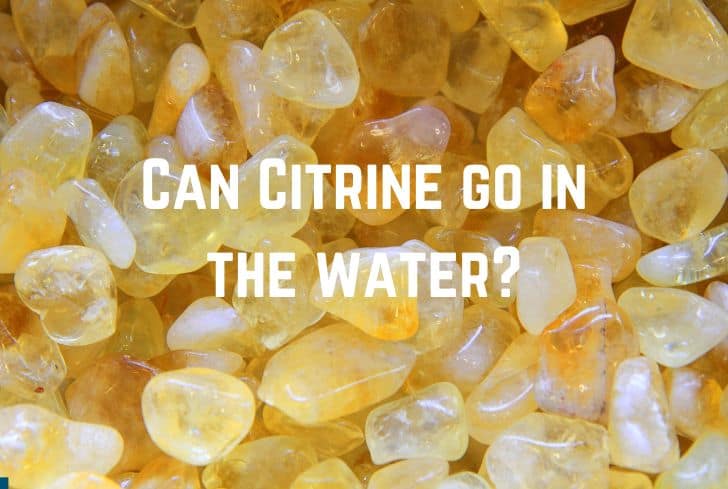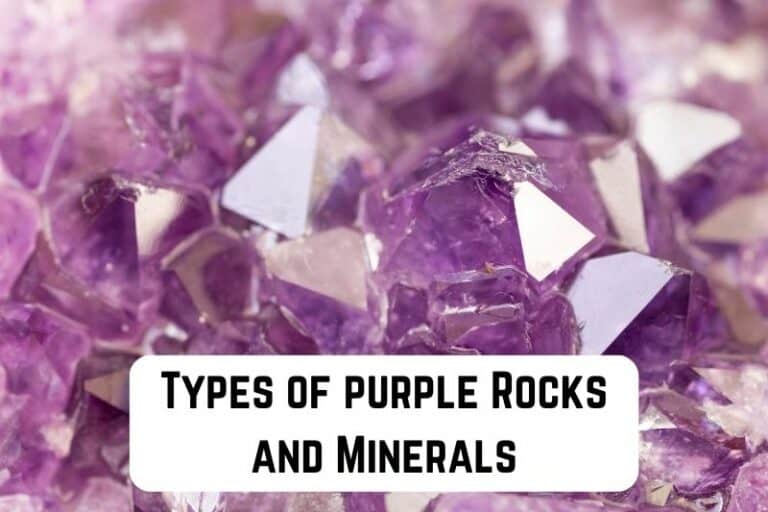13+ Different Types of Green Rocks and Minerals (+Pics)

Green rocks and minerals can be found worldwide and appear in many forms, making them an intriguing subject for exploration. As you delve into the world of vibrant green gemstones, understand that these minerals derive their color from their chemical composition and crystal structures. This article aims to introduce you to 13+ types of green rocks and minerals that boast stunning hues and fascinating properties.
From the famous emerald to the lesser-known actinolite, each green rock and mineral has its own unique characteristics. You’ll learn about their formation, mineral properties, uses, and even some folklore associated with them. The variety of green gemstones is a testament to the ever-intriguing world of geology.
So, buckle up for an exciting journey as we explore these wonderful green gems. Discovering the stories behind their beauty and uses throughout history will pique your curiosity and deepen your appreciation for the rich tapestry of our planet’s geology.
13+ Types of Green Rocks and Minerals
1. Glauconite

Glauconite is a fascinating green mineral that can be found in various rock formations. This unique mineral has a bluish-green hue and is composed of mixed-layer clay minerals, such as smectite and glauconite. It is often found in sedimentary rocks like sandstones, where it forms rounded, dark green, sand-sized nodules.
When you encounter glauconite in the field, you may notice that it can be easily confused with other green minerals like chlorites or celadonite. However, keep in mind that glauconite is considered diagnostic of certain geological environments, particularly shallow marine sediments that contain its characteristic rounded greenish grains.
In some cases, glauconite can be so abundant within a rock that it forms what is commonly known as “greensand” or green sandstone. This interesting rock has been given its name due to the greenish color imparted by the presence of glauconite grains. As you explore the world of green rocks and minerals, it’s a good idea to remember that glauconite is just one among many other fascinating examples, each with its own unique properties and geological contexts.
As you continue your journey through the realm of green rocks and minerals, you’ll undoubtedly come across many more specimens that showcase the diverse beauty and complexities of the natural world. So when you find glauconite, take a moment to appreciate its distinctive bluish-green hue and ponder the geological processes that led to its formation.
2. Green Schist

Green Schist is a unique and fascinating type of rock that gets its name from its distinct green color. You might be curious about what causes this green hue and the minerals that make up this beautiful rock. In Green Schist, the abundance of green minerals like chlorite, serpentine, and epidote, along with platy minerals such as muscovite and platy serpentine, give it the characteristic green appearance.
This rock, which features a tendency to split into layers, is also known for its schistosity, which is due to the platiness of the minerals. Besides the green minerals, you’ll also find quartz, orthoclase, talc, carbonate minerals, and amphibole within Green Schist.
Don’t be surprised if you encounter Green Schist in metamorphic rock formations when you’re out exploring. It forms as a result of a moderate level of heat and pressure exposure – conditions that cause the growth of platy minerals and lead to a schistose texture.
Some distinctive green minerals you might find in Green Schist and other rocks include mariposite, dioptase, fuchsite, uvarovite, and variscite. While these minerals may not be as common as the typical green minerals found in Green Schist, they can still be discovered in various parts of the world.
So next time you’re hiking or exploring nature, watch for Green Schist and its captivating green hue. Apart from being just beautiful to look at, understanding the various minerals in the rock and their properties helps to appreciate the geological processes that have shaped the world around you. Enjoy your next rock hunt!
3. Serpentinite
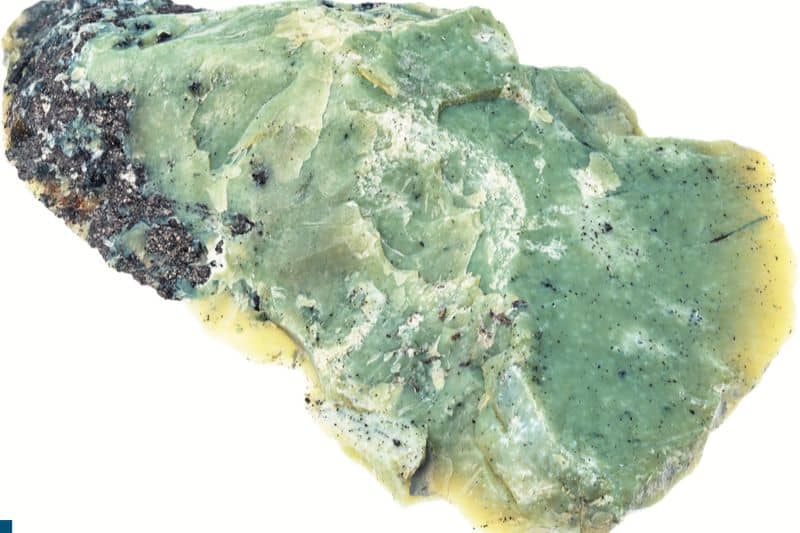
Serpentinite is a fascinating green metamorphic rock that you might come across in your exploration of green rocks and minerals. This rock is primarily composed of minerals from the serpentine group, such as antigorite, lizardite, and chrysotile. These minerals give serpentinite its characteristic green color and layered, banded appearance.
In your journey to discover serpentinite, you’ll notice that its texture may vary from non-foliated to weakly foliated. The grain size of the rock can also vary, creating a unique and interesting appearance. Serpentinite’s mottled green and gray coloration makes it stand out among other green rocks and minerals.
One reason serpentinite is worth your attention is its metamorphic origins. This rock forms from the hydrothermal metamorphism of peridotite, which is a dense, coarse-grained rock originating from the Earth’s mantle. The metamorphic process occurs when hot, mineral-rich hydrothermal fluids flow through the rock, causing chemical reactions that form the serpentine group minerals.
Aside from its captivating appearance, serpentinite has practical uses as well. It can be a source of magnesium and asbestos and is often used as a decorative stone. With its unique characteristics and practical applications, serpentinite is truly an intriguing green rock to explore and appreciate.
4. Eclogite
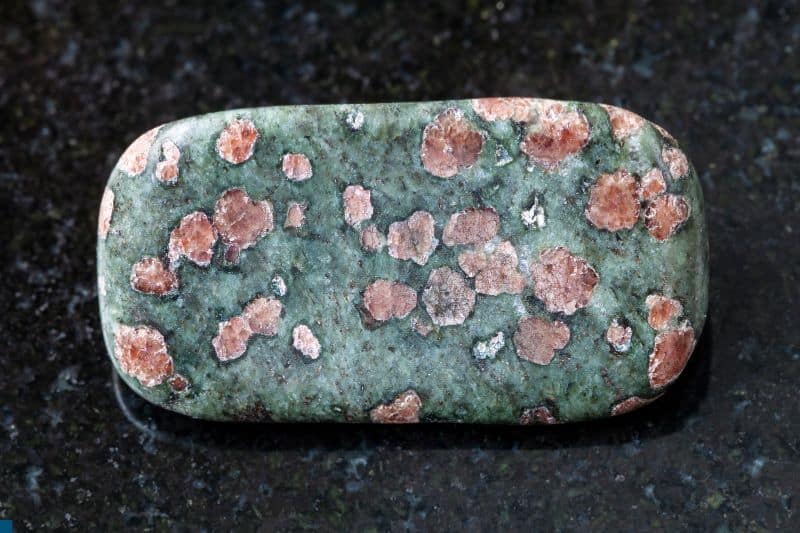
Eclogite is a fascinating and uniquely colored metamorphic rock composed mainly of red garnet and green omphacite minerals. As you explore the world of green rocks and minerals, you will find that eclogite stands out due to its contrasting colors and appearance. It’s formed under high-pressure conditions in the Earth’s crust, making it a rare and interesting specimen for rock enthusiasts like yourself.
When you come across eclogite, you’ll notice that its garnets are usually iron-rich pyrope, containing a similar amount of magnesium and iron. These red garnets create a distinctive visual contrast with the green omphacite, a pyroxene group mineral composed of jadeite and diopside. This beautiful color combination is one of the reasons why eclogite catches your eye.
As you study eclogite, you may also learn that it often occurs as xenoliths, foreign inclusions, in igneous rocks and isolated blocks within metamorphic rocks. Interestingly, eclogites somewhat resemble chondritic meteorites in composition, adding another layer to their geological intrigue.
While eclogite may not be as well-known as other green rocks and minerals like emeralds or jade, it’s worth adding to your collection or geological knowledge. Its unique composition and vivid colors showcase the diversity and beauty of the natural world, making eclogite a fascinating example of the wonders beneath the Earth’s surface. Remember to keep an eye out for this captivating rock as you continue exploring green rocks and minerals.
5. Prehnite

Prehnite is a pale green to gray, glassy silicate mineral that is often found lining cavities in igneous rocks. You might also come across it as stalactite masses. This intriguing mineral is a basic calcium and aluminum silicate (Ca2Al2Si3O10(OH)2) and typically forms as a secondary or hydrothermal mineral in association with zeolites. It can be found in locations such as Italy, Germany, France, Scotland, and New Jersey in the United States.
Although it has traditionally been considered a minor collector’s gemstone, the discovery of relatively recent deposits in Africa containing facetable Prehnite in large quantities has increased its availability and popularity. As you explore the world of Prehnite, keep in mind that it’s a sensitive material. This gemstone is highly susceptible to heat and has perfect cleavage, which means it can easily chip if not handled carefully.
In addition to its captivating appearance, Prehnite is also valued for its metaphysical properties. Some people believe that it can enhance intuition, bring peace and calmness, and aid in spiritual growth. So, as you admire the beauty of Prehnite, consider not only its aesthetic appeal but also the potential benefits it might offer on a deeper level.
While exploring green minerals and rocks, you may also come across other fascinating examples, like dioptase, fuchsite, uvarovite, and variscite. Each of these minerals has unique characteristics and can be found in different settings, so be sure to watch for them while searching for green rocks and minerals.
6. Emerald

Emeralds are a beautiful and well-known gemstone, belonging to the beryl mineral family. They have a rich, distinctive green color and can be found in igneous, metamorphic, and sedimentary rocks in various locations worldwide. As you explore the world of green rocks and minerals, it’s essential to understand more about these stunning gems.
Gemologists, geological laboratories, and colored stone dealers often classify stones as green beryl when their color is considered “too light” for them to be an emerald. The primary hue is green, with yellow and blue being the common secondary hues found in emeralds.
As you examine the internal structure of an emerald, you’ll notice that most emeralds have many inclusions, creating an internal wonderland within the gemstone. These inclusions, while considered flaws to some, offer a fascinating insight into the formation and history of the stone.
When it comes to choosing emeralds, remember that their hue, saturation, and tone play a crucial role in determining the gem’s overall quality. The bluish-green to green shades are highly sought after and considered more valuable. On the other hand, a more yellowish-green color might not be as desirable.
So, as you delve into the captivating world of green rocks and minerals, be sure to appreciate emeralds’ unique characteristics and history. These gemstones have been adorning our world and captivating our imaginations for thousands of years, and their beauty continues to inspire today.
7. Jade
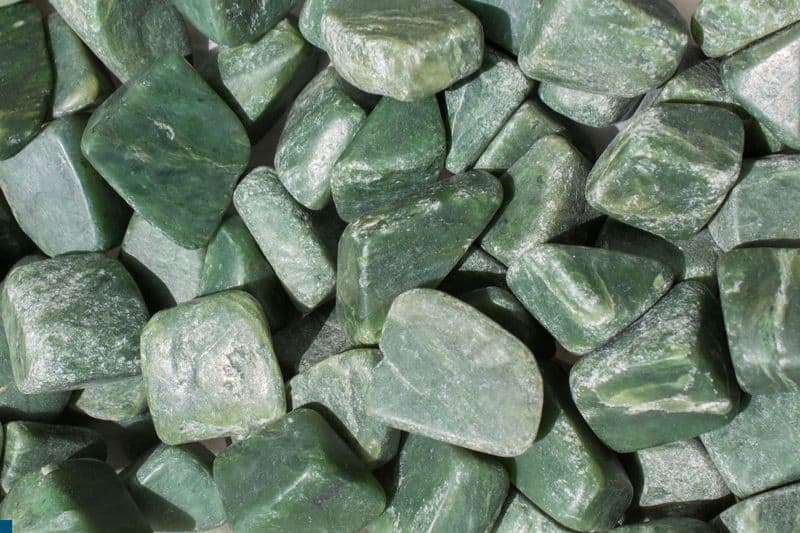
Jade is a beautiful and versatile green gemstone well known for its cultural importance in East Asian, South Asian, and Southeast Asian art. It can refer to either of two different silicate minerals: nephrite, which is a silicate of calcium and magnesium, or jadeite, a silicate of sodium and aluminum (Wikipedia).
As you explore the world of jade, you will notice that it has deep cultural roots dating back to prehistoric humans. This gemstone was used in various forms, from weapons and tools to ornaments and ritual objects (GIA). The carvings made from jade were believed to invoke powers of heaven and earth as well as mystic forces of life and death.
Jade can occur in a variety of colors such as white, red, violet, or gray due to the presence of iron, chromium, or manganese impurities. However, the emerald-green jadeite variety is the most prized type of jade (Britannica).
When incorporating jade into your collection or as a piece of jewelry, keep in mind its rich cultural history and unique properties. Your jade stone might be a stunning addition to your collection and a powerful symbol representing strength, protection, and connection to ancient cultures.
8. Peridot
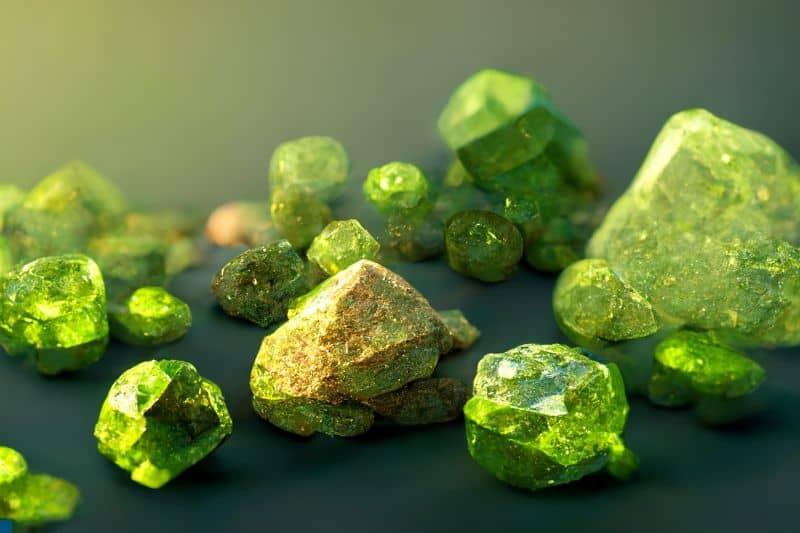
Peridot is a beautiful yellowish-green gemstone that’s a part of the olivine family. It’s a popular choice for those born in August, as it serves as their birthstone. The unique color of peridot ranges from light green to olive, and it has a refractive index between 1.65 and 1.69, giving the stone its distinct brilliance.
You might be interested to know that in 2005, peridot was discovered in the comet dust brought back to Earth by the Stardust robotic space probe. This fascinating detail shows that these magnificent green stones aren’t just unique to our planet but are also present in outer space. Peridot is a gem variety of the mineral olivine, which can be found in peridotite rock from the Earth’s upper mantle. Due to its olivine content, peridotite rocks often exhibit a noticeable green color.
When it comes to sourcing peridot, most gem-quality specimens are found in basalt flows, limestones, and dolomites. A significant portion of the world’s commercial-quality peridot is mined at the San Carlos Apache Reservation in Arizona. Apart from being an attractive gemstone for jewelry, peridot’s vibrant green color makes it a favorite of mineral collectors and rock lovers alike.
In conclusion, peridot is a stunning green gemstone with a rich history and an otherworldly connection. Its distinct color and brilliance make it a sought-after choice for those looking to add a touch of uniqueness to their jewelry collection or mineral display. As you explore the world of green rocks and minerals, make sure to keep peridot in mind!
9. Aventurine
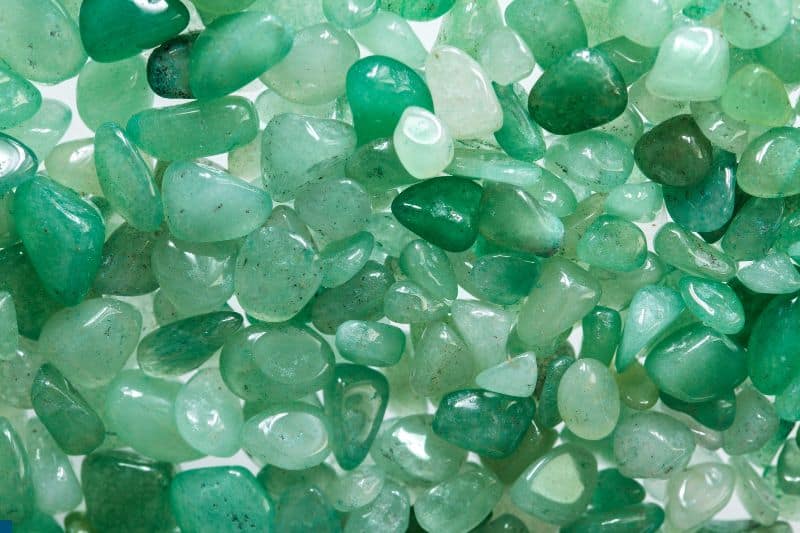
Aventurine is a beautiful green stone that is known for its vibrant, eye-catching color. Often found in shades of green, aventurine can also appear in hues of orange, brown, yellow, blue, and grey1. The most common color, however, remains to be green.
As you may wonder about the origin of aventurine’s unique sparkling effect, it is due to chrome-bearing fuchsite, a variety of muscovite mica that gives aventurine a mesmerizing silvery green or blue sheen. The presence of hematite or goethite can result in its orange and brown shades.
What makes aventurine truly interesting is its translucent nature and highly included appearance. The inclusions are usually a chromium-rich variety of mica called fuchsite, which is finely incorporated within the quartz itself, sometimes in very heavy concentrations.
When it comes to aventurine’s Mohs hardness, it ranges from 6.5 to 7, making it suitable for a variety of applications. In the world of aesthetics and creativity, aventurine has found its place in jewelry and ornament making. It’s often used in stunning pieces that showcase the naturally occurring sparkle of the stone. In a more practical sense, aventurine can also be used for building and landscaping projects.
So, if you’re looking to add a touch of natural wonder and sparkle to your jewelry collection or simply want to explore the fascinating world of green rocks and minerals, aventurine is definitely a gemstone to consider.
10. Malachite
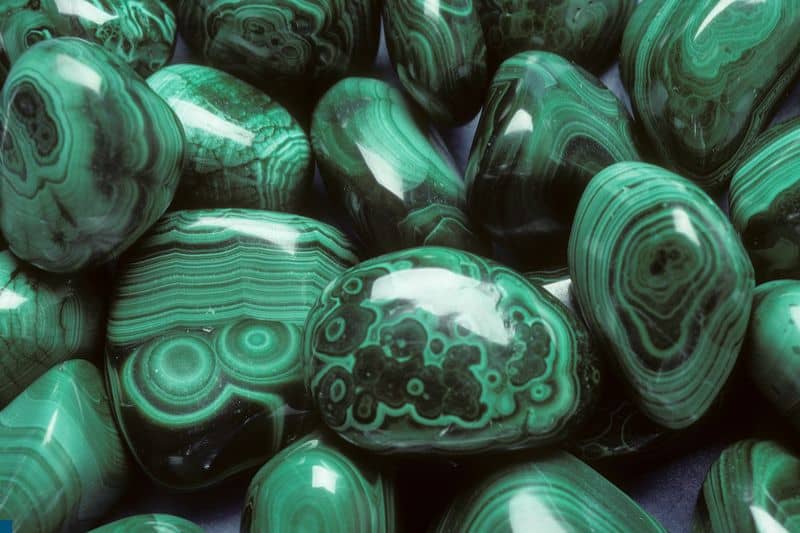
Malachite is a popular green mineral known for its intense color and beautiful banded patterns. This green gemstone is made up of dense intergrowths of tiny, fibrous needles that create unique formations in the stone. The color ranges from pastel green to a very dark shade that is almost black.
As a copper carbonate mineral (Cu2CO3(OH)2), malachite has a striking connection to copper deposits. In fact, its bright green color and presence in weathered zones near copper deposits make malachite a useful prospecting guide for this metal. You’ll find this enchanting green stone in various parts of the world, particularly in copper-producing regions.
When collecting or displaying malachite specimens, you might come across different varieties of this mineral. One such variety is Azure-Malachite, which is a mixture of blue Azurite and green Malachite, resulting in a captivating combination of colors. It’s important to note that malachite is typically not treated or enhanced in any way, making it a natural choice for enthusiasts of green minerals (source).
Since malachite is quite abundant and found in various regions, it’s fascinating to observe different specimens and enjoy their unique formations. The allure of this mineral lies in its deep green color, intricate patterns, and the fact that it remains in its natural state, allowing you to truly appreciate the beauty of this captivating green gemstone.
11. Chrome Tourmaline
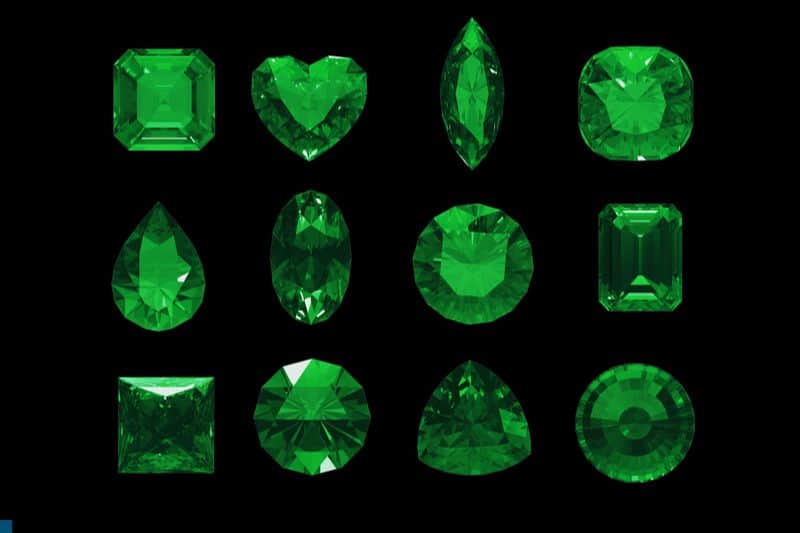
Chrome tourmaline is a rare and beautiful variety of tourmaline mineral species. Known for its deep and vibrant green color, this gemstone is highly prized by collectors and jewelers alike. In fact, many consider chrome tourmaline’s rich green hue to be the top green color for tourmalines. It is worth noting that chrome tourmaline’s price per carat is significantly higher than other green tourmaline varieties, and the price increases after one carat.
You might be curious about what makes chrome tourmaline different from other green tourmalines. The secret lies in its coloring agent, which is chromium. The presence of chromium is a rare occurrence in tourmaline, and it often results in a much brighter and richer green color. This distinct hue sets chrome tourmaline apart from other green tourmalines that obtain their color from iron or vanadium.
Chrome tourmaline is typically found in granite-containing pegmatites, which are rare igneous rocks. Most gem-quality tourmalines, including chrome tourmaline, belong to the elbaite species, rich in sodium, lithium, aluminum, and in some rare cases, copper.
When selecting a piece of chrome tourmaline, it’s essential to pay attention to its color, clarity, and cut. As a general rule, the more saturated and vivid the green color, the more valuable the gemstone. Keep in mind that gemstones that are too dark may be less desirable, as the beauty of the unique green hue might be lost. Moreover, as transparency and clarity contribute to the overall appeal, choose a chrome tourmaline with minimal inclusions or imperfections.
In conclusion, if you’re in search of a stunning green gem with a rich and vibrant color, consider adding chrome tourmaline to your collection. Whether set in a piece of jewelry or displayed as a specimen, this rare and eye-catching mineral will surely stand out among your treasures.
12. Prasiolite

Prasiolite, also known as Green Amethyst, is a rare green variety of quartz. You might be interested to know that its name comes from the Greek words for leek-green stone. The lovely green color of this mineral is often produced by irradiating or heat-treating amethyst containing ferrous iron (Fe 2+) at approximately 500°C. However, there have been instances of natural prasiolite being found.
This gemstone was first discovered in the early 1800s in Silesia, Poland, and has since become a popular choice for those seeking unique green stones. Prasiolite’s unique hue sets it apart from its purple amethyst cousin, making it an attractive choice for jewelry and collectors alike.
One notable characteristic of prasiolite is that it results from the heat treatment or ionizing radiation applied to amethyst gemstones, turning them into a yellowish-green or green color. Almost all prasiolite available in the market today comes from these treatments, according to Geology.com.
As you explore the world of green rocks and minerals, prasiolite is undoubtedly one of the more fascinating gems to consider adding to your collection. Its unique history and striking color make it a fantastic choice for those looking to enhance their assortment of stones and gems with something truly extraordinary.
13. Amazonite

Amazonite, also known as Amazon Stone or Amazon Jade, is a green to blue-green variety of Microcline, which is a Feldspar mineral. This mineral exhibits colors varying from bright verdigris green to paler shades of turquoise, sometimes even having white, yellow, or grey portions. It typically forms in short prismatic, tabular crystals or masses, and can be translucent to opaque.
When you come across Amazonite, you may notice that its shades of green or blue-green can be quite eye-catching. It is often used as a gemstone due to its vibrant colors. This mineral has been frequently confused with jade, though they are distinct minerals in their own right.
In your collection, Amazonite can come in various colors and patterns, giving you a wide range of options to choose from. You might also find it interesting to learn that this gemstone is found in several locations worldwide, including places like Mongolia, South Africa, and Sweden.
So next time you find Amazonite, you can appreciate its beauty and the geological processes that create such stunning green and blue hues. Remember, with its vibrant color and unique patterns, Amazonite is a great addition to any rock and mineral collection, showcasing the amazing diversity of our planet’s geological treasures.
14. Fuchsite
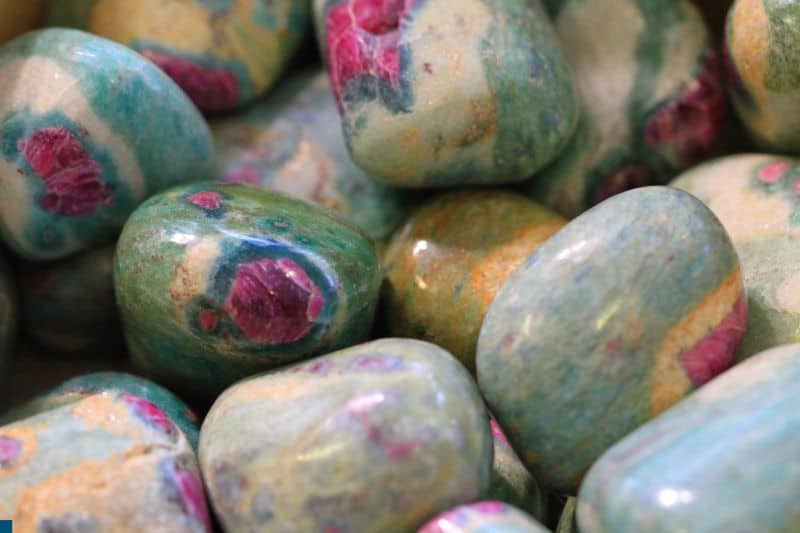
Fuchsite is a green-colored mineral that gets its hue from the chromium content present in it. This fascinating mineral belongs to the mica group and is known for crystallizing in the monoclinic crystal system. The color of Fuchsite can vary from pale green to bright emerald green, depending on the amount of chromium substitution in the crystal structure.
When you first encounter a specimen of Fuchsite, you might notice that its micaceous crystals are flexible and slightly sectile. This makes the mineral quite unique in appearance. It has a hardness of 2-2.5 on the Mohs scale, so it’s relatively soft compared to other minerals. One interesting characteristic of Fuchsite is that it fluoresces lime green when exposed to long-wave UV light, which can add a bit of novelty to your collection.
This gemstone can sometimes be found with corundum crystals, like ruby. The resulting composite material is called ruby in Fuchsite. The contrasting colors of the green Fuchsite and the red ruby make it an eye-catching material for display or jewelry.
In metaphysics and crystal healing, Fuchsite is believed to bring about balance and harmony in one’s life. It’s said to help with emotional and physical well-being, promoting a sense of joy and optimism. While these claims are not scientifically proven, many people appreciate the spiritual and emotional aspects of gemstones, and Fuchsite is no exception.
So, if you ever come across a piece of Fuchsite, take a moment to appreciate its unique physical and metaphysical qualities. Its stunning green color, fluorescent properties, and occasional ruby inclusions make it a worthy addition to your green rocks and minerals collection.


